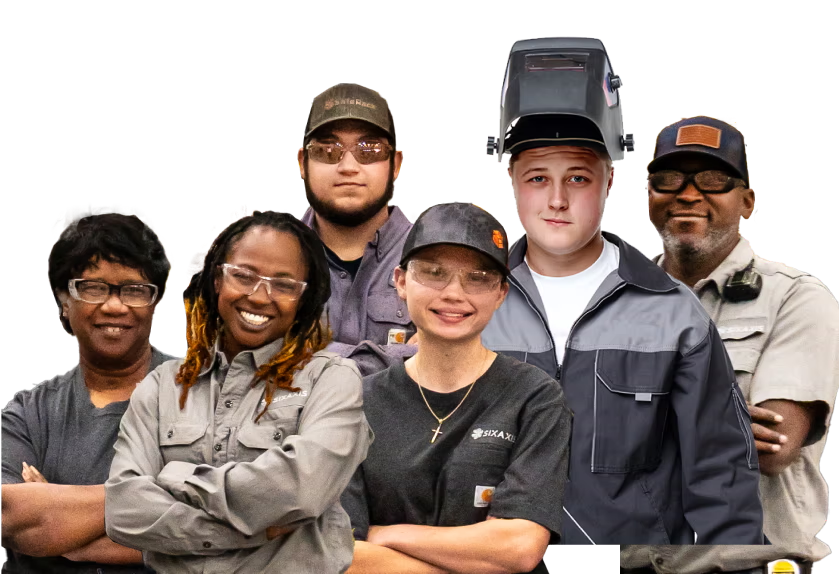Fuel transport safety is a major concern for any company that moves and distributes fuel. Various cargoes require different types of tankers to safely transport them over the road within the Department of Transportation’s requirements. Fuel transport systems, depots, chemical transport companies, and gas transport companies need safe and reliable tankers to hold that material.

Non-Pressurized Liquid Tank
MC-306 (DOT-406)
Common trailer names: Fuel tanker, gasoline tanker
A low-pressure highway cargo tank with an oval/elliptical cross-section is optimized for multi-stop delivery of Class 3 flammable liquids. Vacuum loading is not allowed under this spec.
Key Details:
- MAWP: 2.65–4 psig (design), tested per DOT-406; vacuum loading prohibited.
- Construction: Typically aluminum, often multi-compartment with baffles for split loads; oval section improves stability.
- Typical capacity: Up to ~9,000 gal (varies by configuration and jurisdiction).
Commonly Cargo:
- Gasoline, Diesel, Jet fuel
- Other compatible non-pressurized liquids where allowed.
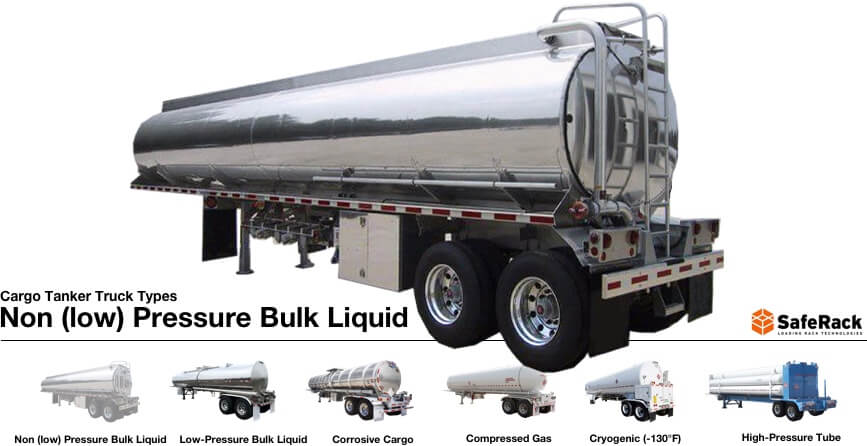
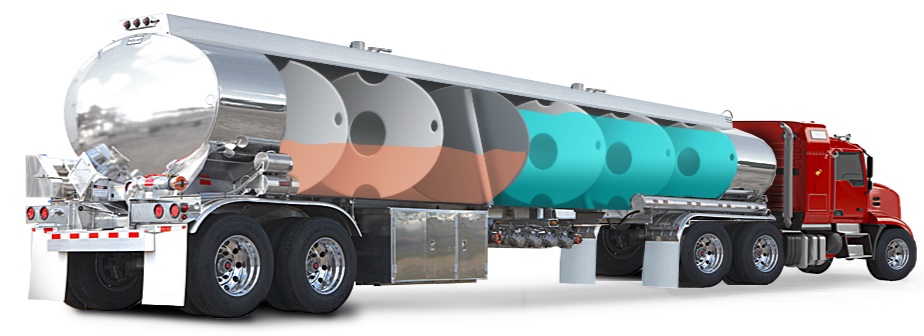
Low-Pressure Chemical Tankers
MC-307 (DOT-407)
Common trailer names: Chemical tanker (low-pressure), 407 tanker
General-purpose chemical cargo transport tank; usually appears “horseshoe-shaped” when insulated (outer jacket), circular if uninsulated.
Key Details:
- MAWP: ≥25 psig; certain designs may exceed 35 psig with ASME construction.
- Cross-section: Circular (inner tank); insulation/jacket can give a horseshoe appearance.
- Typical capacity: Around ~6,000 gal; can be insulated or uninsulated.
Common Cargo:
- Solvents, lubricants, mild corrosives, some flammable/combustible liquids
- Food-grade liquids like vegetable oils or syrups can be configured accordingly.
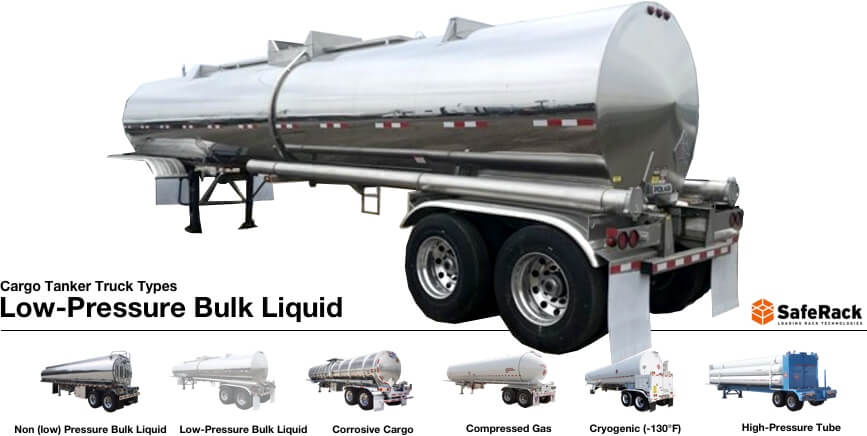
Corrosives Tank
MC-312 (DOT-412)
Common trailer names: Acid tanker, corrosives tanker
Heavily reinforced corrosive-service cargo tank with visible external rings, lined to handle aggressive chemicals.
Key Details:
- Typical internal pressure range ~35–50 psig (application-dependent).
- Materials/lining: Stainless steel with rubber or plastic lining is common; it may be insulated.
- Geometry: Cylindrical, smaller diameter/longer length (“cigar” shape) with rear bottom outlets typical.
Common Cargo:
- Sulfuric acid, nitric acid, sodium hydroxide
- Other Class 8 liquids within the spec.
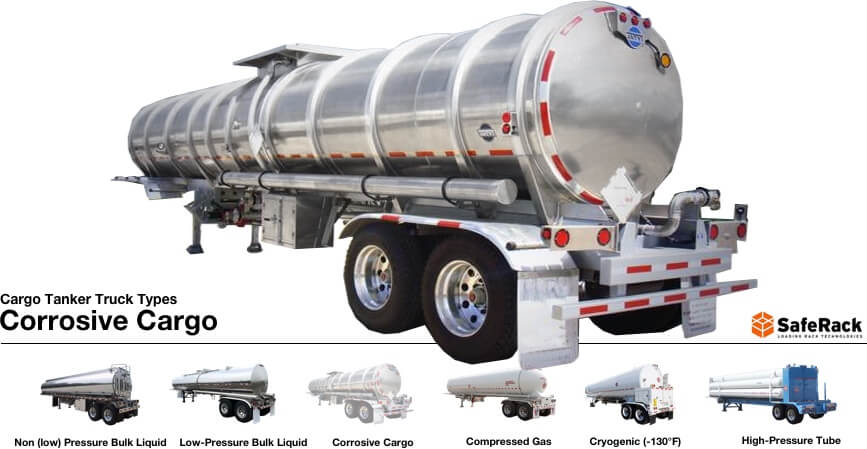
Internal Pressure Specifications
| Code | Test Pressure |
|---|---|
| MC 300, 301, 302, 303, 305, 306 | 20.7 kPa (3 psig) or the designed pressure of the tank, whichever is greater |
| MC 304, 307 | 275.8 kPa (40 psig) or 1.5 times the design pressure of the tank, whichever is greater |
| MC 330, 331 | 1.5 times either the maximum allowable operating pressure or the re-rated pressure, whichever applies. |
| MC 338 | 1.25 times either the maximum allowable operating pressure or re-rated pressure, whichever applies. |
| DOT 406 | 34.5 kPa (5 psig) or 1.5 times the maximum allowable operating pressure (MAWP), whichever is greater. |
| DOT 407 | 275.8 kPa (40 psig) or 1.5 times the MAWP, whichever is greatest. |
| DOT 412 | 1.5 times the MAWP, (Maximum Allowable Operating Pressure) |
Compressed Gas Tank
MC-331
Common Trailer Names: LPG tanker, propane/butane trailer, anhydrous ammonia trailer
High-pressure cargo tank for liquefied gases under pressure; thick-walled steel with rounded ends and protected appurtenances.
Key Details:
- Pressure range: ~100–500 psig (by service); single-shell carbon steel construction.
- Typical capacity: ~3,500 gal (bobtail) to ~11,500 gal (semi-trailer).
Common Cargo:
- Propane (LPG)
- Butane
- Anhydrous ammonia
- Chlorine (specialized)
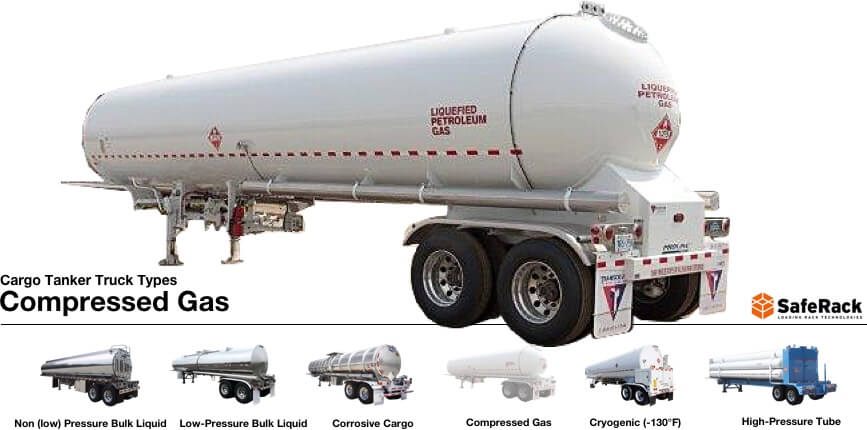
Cryogenic Liquid Tank
MC-338
Common trailer names: Cryo tanker, liquid gas trailer
Vacuum-insulated, double-walled tank for deep-cold liquids (≤ −130°F), often with a rear cabinet for valves and controls.
Key Details:
- Construction: Inner/outer cylinders with vacuum annulus (thermos-like design).
- Pressure: Service pressures vary (~23.5 to 500 psig, lower end typical for many cryogens); designed to minimize heat leak and venting.
- Regulated under MC-338 specification.
Common Cargo:
- Liquid oxygen
- Nitrogen
- Argon
- Hydrogen
- CO₂
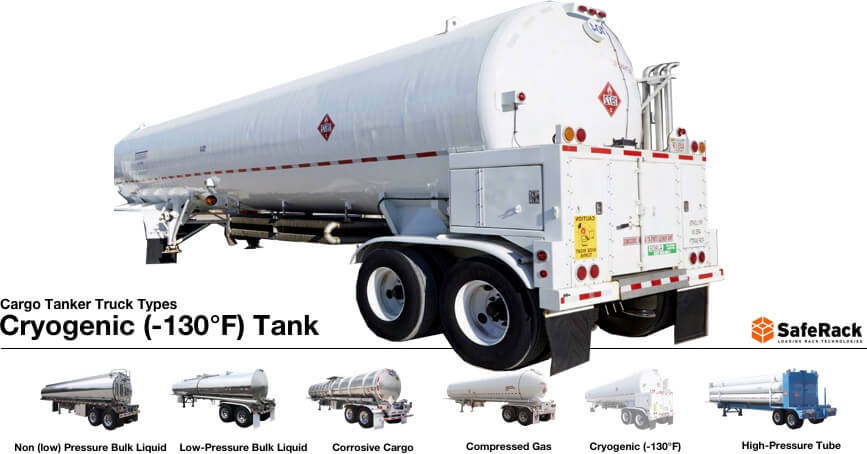
High-Pressure Tube Trailer
MEGC (Multiple-Element Gas Container)
Common trailer names: Tube trailer, MEGC trailer
Frame-mounted bundles of high-pressure tubes/cylinders manifolded together; used where gases cannot be economically liquefied for transport.
Key Details:
- Regulatory basis: MEGC requirements in 49 CFR §178.75 (design/marking/approval).
- Typical per-tube pressure: ~4,000–6,000 psig; tubes controlled/isolated via rear manifold.
Common Cargo:
High-purity or industrial gases (e.g., helium, nitrogen, oxygen, argon).
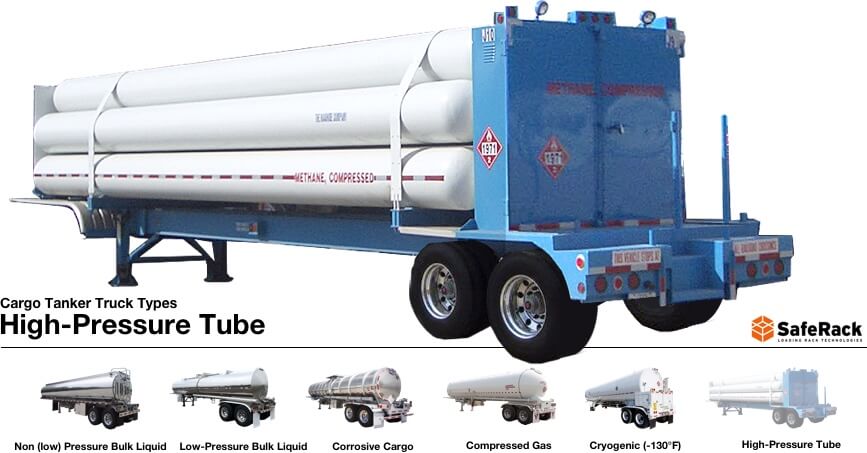
Dry Bulk / Pneumatic Hopper Trailer
Common trailer names: Pneumatic dry-bulk, silo tanker, bulk powder trailer
A pneumatic hopper trailer is a cylinder tank with cone hoppers that is loaded by gravity through top manways and unloaded with air pressure through bottom piping.
Key Features
- Operating pressure: Typically ~15–22 psig depending on model/application.
- Discharge: Blower-assisted pneumatic conveyance to silos or bins; multiple hoppers with dedicated valves.
Common Cargo
- Cement, lime, sand, plastic pellets, fertilizers
- Configured for sanitary service for food-grade powders like flour and sugar.
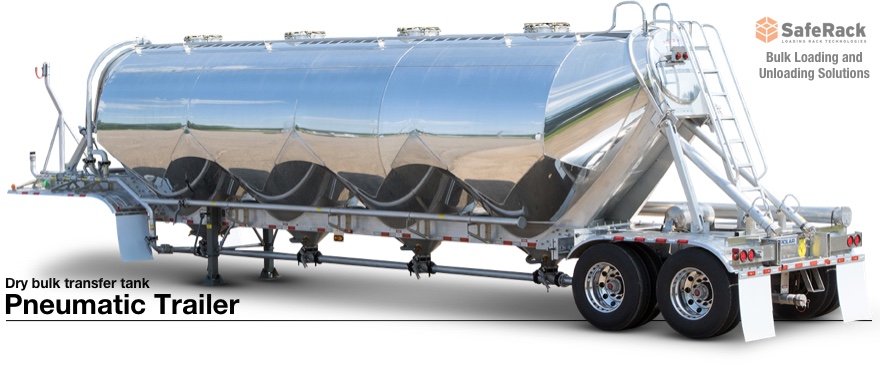
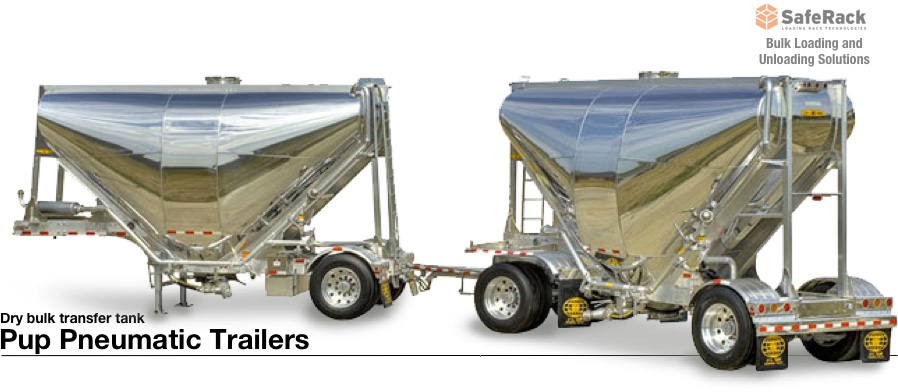
Tanker Truck Safety Features
View full article on Road Tanker Safety

Baffles
Baffles are placed inside tanks to prevent maximum forward and rearward motion of the stored liquid within the tank. When a truck that is hauling a high viscous material comes to a halt, the liquid in the tank generates a great deal of force due to the forward motion of the cargo. To distribute the force evenly and to limit the transfer of energy, install vertically large-holed plates or cages that divide and slow the flow of moving liquid.
Liner
Liners are designed to increase the operational time of a tank. Tank liners protect steel, stainless steel, and aluminum tanker trailers from the effects of corrosive materials. Many tankers haul solvents and hydrochloric acids with concentrations greater than 20% making a liner is an absolute requirement.
Vapor Recovery Systems
Vapor recovery systems are installed on tankers and at loading platforms that handle cargo that should not be dispersed into the atmosphere. These systems capture errant vapors that happen during the loading or unloading of a product and return them to the cargo hold. Good vapor recovery systems save money by reducing lost product.
Overfill Protection
Overfill protection prevents spills and ignition hazards during loading and unloading by using high-level probes in each compartment and a rack monitor that permits flow only when the safety circuit checks out—then shuts down automatically if product reaches a set point or a fault is detected.
Pumps & Metering (Bulk Loading and Transloading)
Pumps are the heart of bulk loading and transloading systems, moving product from storage tanks, railcars, or trucks into outbound vessels efficiently and safely. In petroleum, chemical, and food-grade operations, the pump must be matched to the fluid’s viscosity, compatibility, and required flow rate.
Adding a metering system to the pump skid provides precise product measurement during transfer, supporting inventory control, billing accuracy, and regulatory compliance, and can include digital readouts, ticket printers, and automated data capture.
Grounding
Grounding ensures a secure, low-resistance electrical bond between a tanker and the loading rack to safely dissipate static electricity generated during product transfer. Without proper grounding, a static discharge could ignite flammable vapors, creating a serious fire or explosion hazard. Modern grounding systems, like those offered by SafeRack, use continuous monitoring to verify the bond before and during loading—locking out pumps or valves if the connection is lost. Our grounding monitors can be integrated with overfill protection in a single rack-mounted unit, providing both safety functions in one interface. Options include visual indicators, event logging, and compatibility with a variety of clamps, reels, and connection methods to suit petroleum, chemical, and food-grade loading operations.



